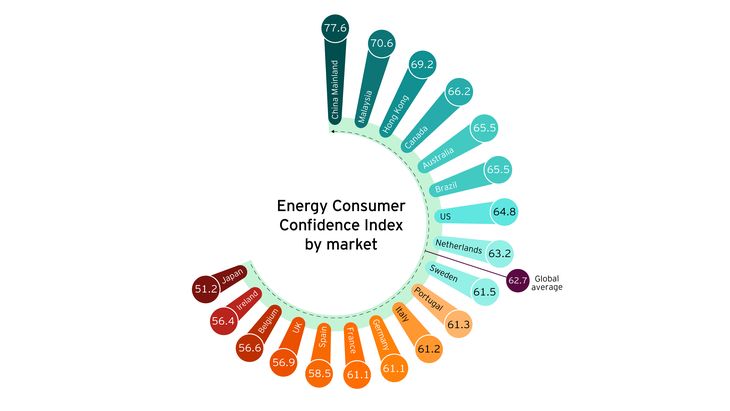The energy transition is in full swing, but are consumers convinced of the benefits? Wavering consumer confidence may stall progress, according to a new Energy Consumer Confidence Index (ECCI).
Modelled on established consumer confidence indicators, the ECCI draws upon an EY survey of 36,000 residential energy consumers across 18 markets to understand consumer confidence today and three years from now, across five factors – the stability of energy providers’ business; value created by providers for consumers and their community; ability to access clean energy options; access to affordable energy; and regulator or government support for a fair and equitable energy transition. The results reveal some stark findings – consumers are struggling to see the benefits of the energy transition now and aren’t confident that things will improve in the future.
“EY developed the Energy Consumer Confidence Index designed to measure how confident consumers feel about their own energy situation, the energy market, and the future of the energy transition. The energy transition requires changes to consumers’ lifestyles, homes, and vehicles. Currently, many markets are on a downward confidence trend, as consumers are still in the early stages of understanding the impact of the transition on their routines, actions, and investments,” said Mihai Drăghici, Director, Consulting, EY Romania.
Energy transition progress and consumer confidence
To better understand the impact of the energy transition on consumer confidence, EY has mapped the ECCI against the World Economic Forum’s Energy Transition Index, which benchmarks countries across 38 indicators of energy transition progress. The findings reveal an interesting correlation between countries’ progress in the energy transition and energy consumer confidence. As a market progresses through the energy transition, consumer confidence first rises, reflecting positive sentiment around the possibilities of the future, before falling sharply. It seems that as the scale, complexity and disruption of the journey move from theory to reality, the impacts hit home.
The index also finds a link between consumer confidence, accessibility and affordability. For example, consumers on lower incomes have lower confidence, perhaps reflecting a feeling of being unable to access or afford new energy solutions, such as rooftop solar, home battery storage and electric vehicles. To date, a focus on higher-income consumers as the early adopters of these solutions has made it more difficult for people on lower incomes to participate in the energy transition and see its benefits.
Lessons from different market approaches
Certain markets have managed to avoid the link between energy transition progress and poor confidence. In France, a combination of market design, government interventions and nuclear power generation, has helped create a predictable and stable market structure. In the Netherlands, proactive community engagement and broad collaboration across society has given consumers’ confidence in their ability to access safe, affordable energy in the future. Similarly, Sweden stands out as leading the way thanks to new energy projects that deliver lower energy costs, new jobs, and increased tax revenue for local communities.
These examples demonstrate the importance of early consumer engagement in the value of the energy transition, as well as the need for government and regulators to create a predictable, stable foundation for the energy experience. Compare this with the UK, where consumers have borne the brunt of retail volatility, significant price increases and failing energy suppliers — and where confidence is low. Meanwhile, in the US, the energy transition is still at an early stage, and consumer confidence is relatively high. As investment and policy grows, however, a focus on maintaining consumer confidence must be a priority or clean energy ambitions may be at risk.
Collaboration around four key actions
The success of the energy transition depends on rebuilding consumer confidence now — and it will require a concerted cross-sector, cross-government effort. All players in the energy ecosystem need to come together to give consumers the energy experience they want.
EY has identified four key actions that can encourage and support consumers to make behavioral changes and investments that will accelerate our journey to a better energy future: 1) Collaborate to create consumer-centric ecosystems; 2) Target lifestyles and individual actions; 3) Value the energy intangibles; 4) Master behavioral science.
